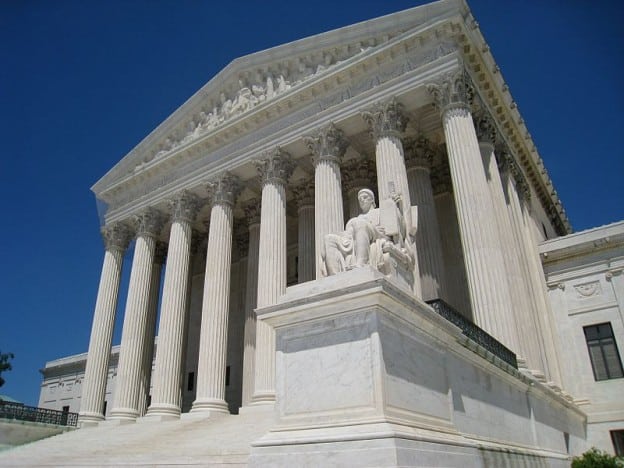SCOTUS Hears Arguments on EPA’s Purview Over Power Plant GHG Emissions
Credit to Author: Sonal Patel| Date: Mon, 28 Feb 2022 16:19:31 +0000

The U.S. Supreme Court is hearing arguments on a landmark case that could determine whether the Environmental Protection Agency (EPA) has the authority to broadly interpret the Clean Air Act (CAA) to establish carbon emission standards for coal, oil, and gas–fired power plants.
Arguments in West Virginia v. Environmental Protection Agency (No. 20-1530) presented to the high court on Feb. 28 focus on a singular question: In 42 U.S.C. § 7411(d)—an ancillary provision of the CAA—did Congress constitutionally authorize the EPA to issue significant rules to decarbonize the power sector (and any other sector) without limits on what the agency can require, as long as it considers cost, non-air impacts, and energy requirements?
A Lengthy Battle Over Power Plant GHG Regulation
West Virginia v. Environmental Protection Agency, arguably, is the most important environmental case in the past decade, and it has a long history. It stems from the Obama administration’s 2015-finalized Clean Power Plan (CPP), which allowed regulators to determine the best system of greenhouse gas (GHG) emissions reductions for power plants. Before legal challenges to this rule could be decided, and bolstered by the Supreme Court’s February 2016 stay of the rule, the Trump administration repealed the rule and replaced it with the Affordable Clean Energy (ACE) rule in 2019 based on a new and more narrow interpretation of the relevant CAA provision.
However, the D.C. Circuit in a 2–1 decision in January 2021 vacated the EPA’s ACE rule and its repeal of the CPP, ruling that ACE rulemaking was made in an “arbitrary and capricious” manner. After 19 states, led by West Virginia, and some power companies challenged the D.C. Circuit’s ruling, the U.S. Supreme Court in October 2021 took up the case, consolidating four separate petitions, including the case led by West Virginia, another from North Dakota, and two from coal mining corporations (Westmoreland Mining Holdings and North American Coal Corp.).
The arguments on Monday will focus on the four consolidated cases (20-1530, 20-1531, 20-1778, and 20-1780). A decision is expected before the end of the court’s term this summer, Megan Berge, a partner at law firm Baker Botts, told POWER.
According to Berge, appellants in the case “have raised significant Constitutional questions and questions regarding the level of deference courts should give agencies in the interpretation of the statutes that they implement.”
Of significant note is that one amicus (“friend of court”) brief is the Edison Electric Institute (EEI), a trade group representing all U.S. investor-owned U.S. utilities. “While it may seem counterintuitive that the nation’s investor-owned electric companies, in particular, should favor EPA regulatory authority, the alternative could be the chaotic world of regulation by injunctive fiat,” the EEI’s brief, filed on Jan. 22, reads. “In short, Amici and their members seek to ensure that the nation’s emissions-reduction policies minimize impacts on consumers and avoid harm to U.S. industry and the economy. The surest path there is affirming EPA’s authority to regulate GHG emissions under the Act, consistent with the Act’s text and congressional intent.” The National Association of Clean Water Agencies, which represents water utilities, also joined the brief.
A Significant Case
Berge underscored the significance of the case. “The challenges to the regulations have become a vehicle for the Supreme Court to speak on broadly applicable principles of administrative and Constitutional law,” she explained. “Notably, this includes whether courts should defer to agencies’ interpretation of ambiguous statutory provisions in cases that involve questions of vast economic or political significance, or major questions. If the answer is no, it will influence challenges to agency actions in myriad areas going forward.”
On Monday, questions from justices focused on a range of concerns, including uncertainty posed by the EPA’s mid-2021 suggestion that the agency will likely seek an alternate plan than the CPP for power plant carbon dioxide emissions. Solicitor General Elizabeth Prelogar told the court during arguments that the EPA is still undertaking preparatory activities, and the agency expects to issue a notice of proposed rulemaking “by the end of this year.”
The Biden administration had previously urged the Supreme Court not to intervene, allowing the EPA to issue its new rule “taking into account all relevant considerations, including changes to the electricity sector that have occurred during the last several years.”
According to Berge, the EPA’s proposed rule may come as early as this summer. “Depending on the outcome of West Virginia, it could significantly alter or delay the rulemaking process for this next iteration of carbon emission standards for existing fossil fuel-fired power plants,” she said.
Sources on Monday also highlighted President Biden’s nomination of Judge Ketanji Brown Jackson to succeed the retiring Justice Stephen Breyer. Breyer was on the bench on Monday morning to hear oral arguments in West Virginia.
This article is being updated live. Check back for new details from ongoing arguments.
—Sonal Patel is a POWER senior associate editor (@sonalcpatel, @POWERmagazine).
The post SCOTUS Hears Arguments on EPA’s Purview Over Power Plant GHG Emissions appeared first on POWER Magazine.